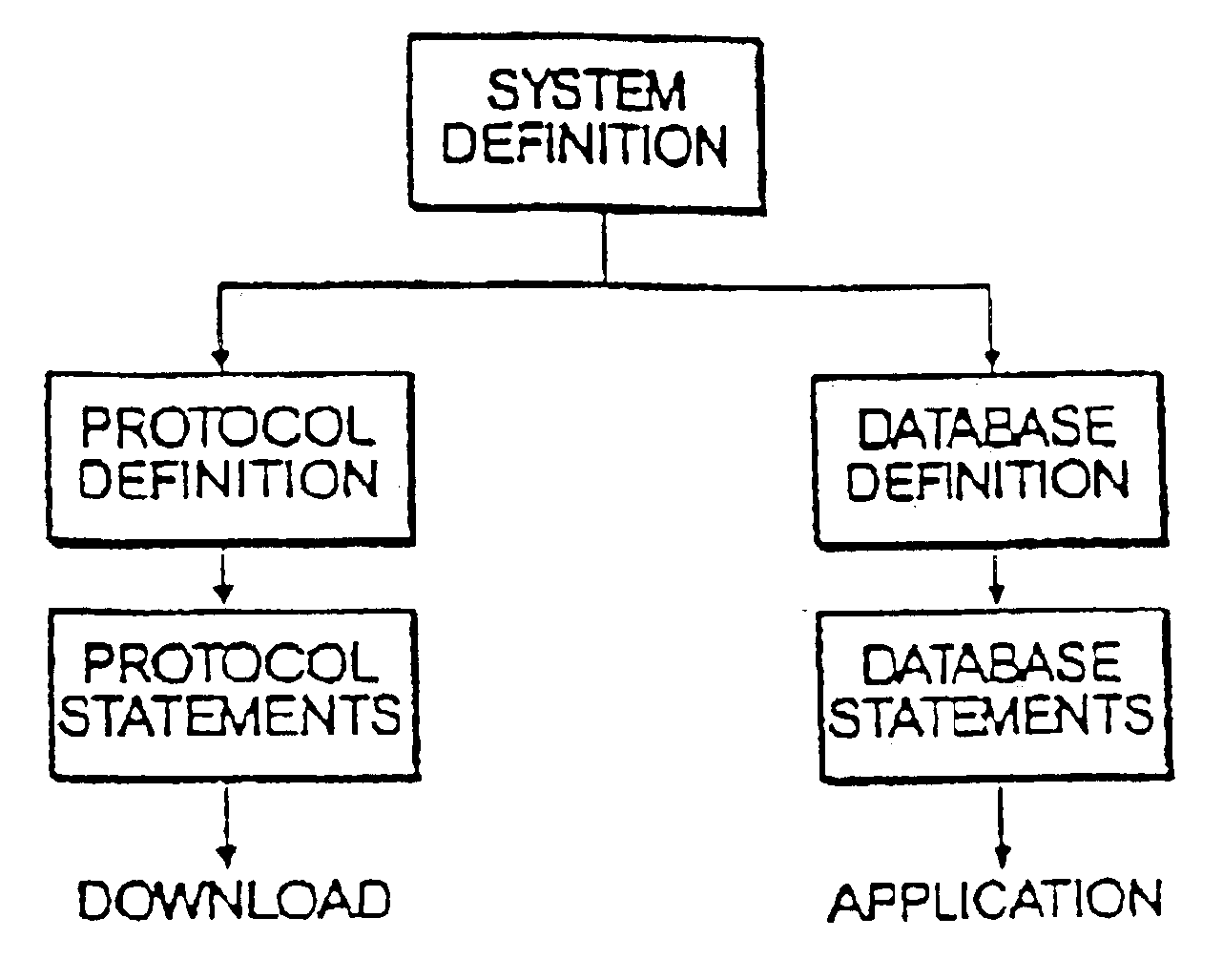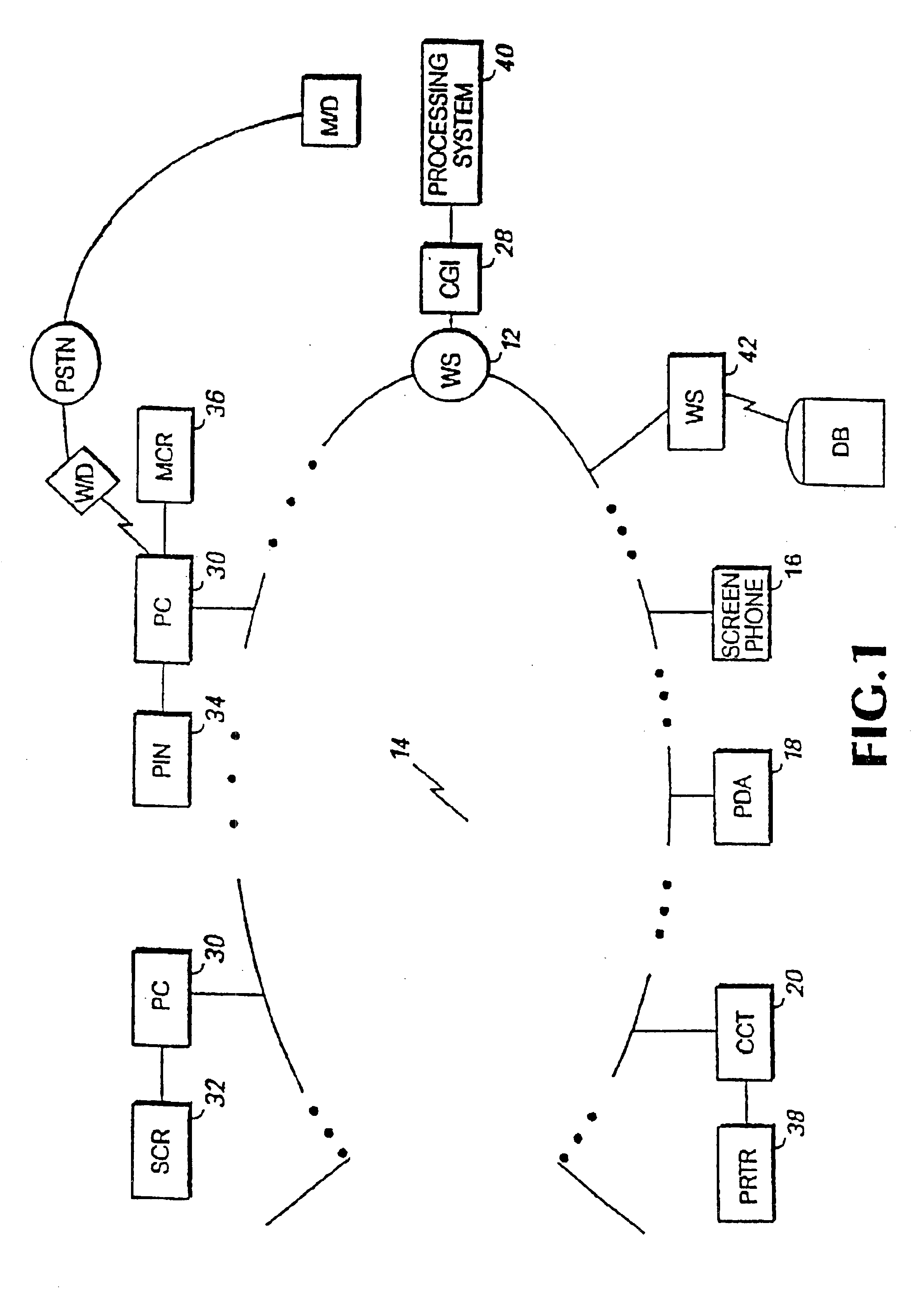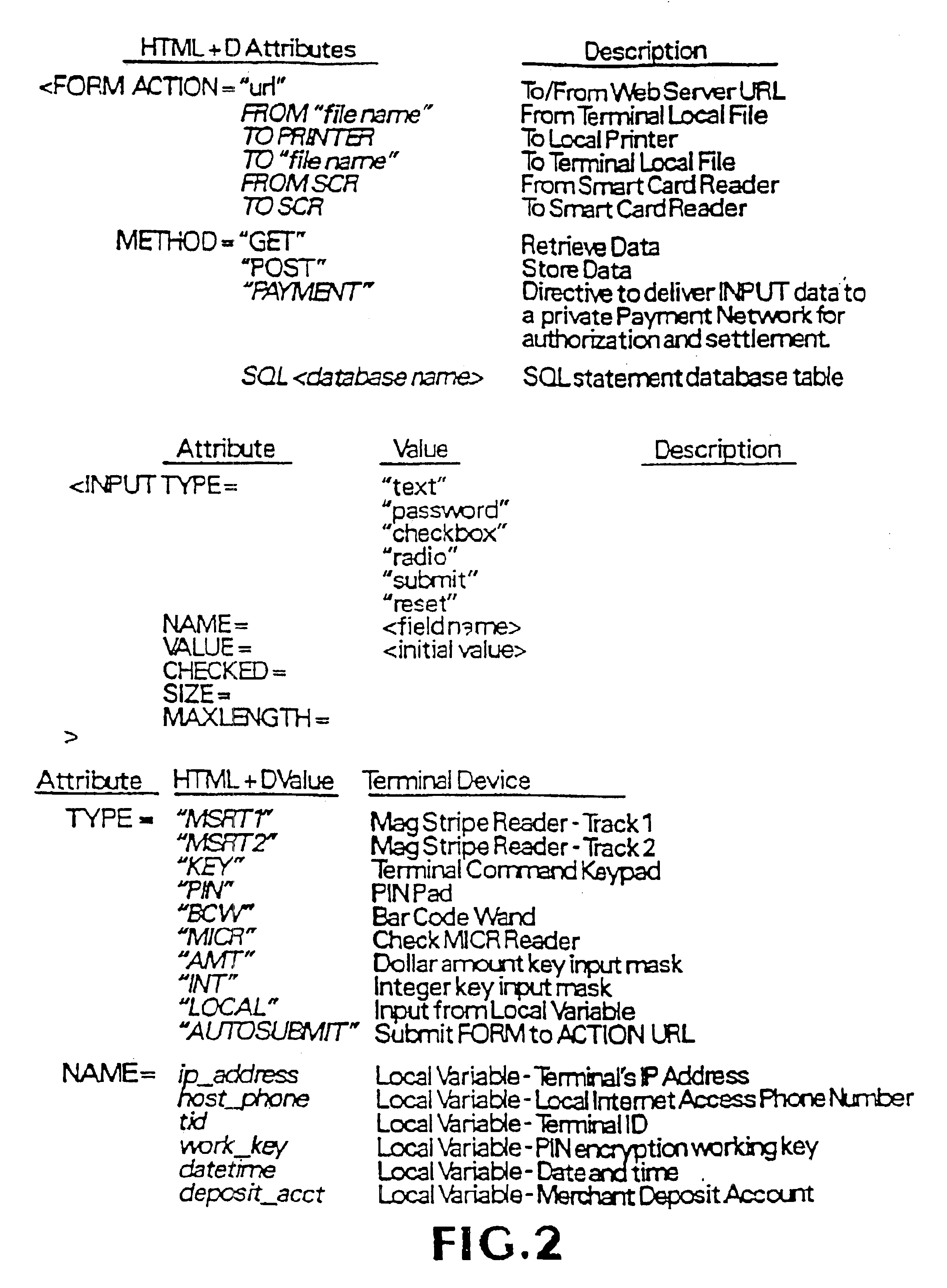[0020]The system of the present invention is implemented by extending present open
network communication protocols and data message formats to communicate with non-standard I / O devices either coupled to an open network as a
client or coupled to an open network through a
client, such as a PC, credit card terminal, screen phone, or PDA. That is, commands which are compatible with the communication schema of a presently-implemented protocol for the Internet are used and additions are made to commands implemented within the control structure of that existing protocol to support non-standard I / O device communication. At the
server, the extended protocol is further supported by a
common gateway interface (CGI) which converts the communication from a non-standard I / O device to a format which is compatible with a transaction or
data application program which may be executed on the
server or a computer coupled to the
server. In this manner, the CGI permits the
processing of the extended capability commands to be segregated from the communication functions performed by the server.
[0021]Preferably, the server and the I / O devices communicate through an
Internet protocol and most preferably, the
Hyper Text Transport Protocol (HTTP), to exchange data between an application program and non-standard I / O devices over an open network. Although HTTP is the preferred protocol used to implement the present invention, other protocols such as
Telnet or SMTP, for example, may also be extended in a similar manner. Specifically, the HTTP protocol is expanded to communicate with printers, magnetic card readers, credit card terminals,
smart card readers, check readers, PIN pads, bar-code readers, PDAs, or the like, and includes a command which instructs a non-standard I / O device to disconnect from the open network and re-couple to a
transaction processing system to transfer funds from a
consumer account to a
merchant account through a PSTN or dedicated data line. By using these extended capability commands within HTTP, a
processing system may operate on an open network such as the Internet and communicate with transaction or other data I / O devices which have not previously been able to couple to such open networks. Such a system may be used to execute a transaction between a
consumer and a merchant so the merchant receives remittance information in a timely manner. The system permits the consumer to initiate a transaction and order from a merchant and then use a more secure link supported by PIN entry devices or the like to reduce the risk of fraud for the transaction.
[0022]Because the server may communicate through such open networks with non-standard I / O devices, the transaction or
data processing system is available for the ever-expanding market available through the Internet. Such a system is able to communicate with non-standard I / O devices in myriad locations such as retail establishments or in consumers' homes. For example, a consumer may utilize the standard capability of an
Internet protocol to communicate with a server that provides information regarding services or goods for sale over the Internet and then consummate a sales transaction by using the extended capability of the
Internet protocol. Such a home consumer could provide
transaction data through a
smart card reader coupled to a COMM1 or COMM2 port of a PC. A
database program executing at the server for the central
processing site may accept product ordering information from a non-standard keypad or touch screen associated with a screen phone terminal at the remote site and then communicate with the
smart card reader to consummate the transaction. Such a transaction system requires that the consumer have physical possession of the smart or credit card and not simply knowledge of the account number. Likewise, the server would be able to communicate with a PIN pad or the like to ensure the hardware
encryption of PINs and other data before it is transmitted to the server site. Such a system is less susceptible to consumer fraud.
[0023]Another feature of the present invention is a
PAYMENT command implemented in the extended Internet protocol that directs a non-standard I / O device or a PC interfaced with such devices to communicate with a transaction processor through an alternative
communication link. In one form, the
PAYMENT command is used by a merchant terminal to submit a consumer's account number with a merchant
deposit account number through a PSTN network or the like to the processing center. In another form of the
PAYMENT command, a
client program in a consumer's terminal receives an account number for a
merchant account from a merchant's server with the PAYMENT command. On
receipt of this command, the client program suspends its operation and passes the account number to a conventional
bank processing program co-resident in memory. The
bank processing program establishes a standard
communication link with a
transaction processing system through a dedicated data line or a PSTN network. Using that communication links the
bank processing program executes a commercial transaction using a standard VISA protocol or the like. The consumer may use a magnetic stripe reader and a PIN entry device to improve the security of the
data transmission. The transaction center may transmit remittance data over the open network to the merchant so the merchant is apprised of
payment and ships the ordered product. Once this consumer initiated transaction is complete, the bank processing program terminates and returns control to the client program which may terminate communication with the open network or retrieve information from another server on the open network for another transaction. In this way, the user may use the open network for non-confidential communication such as collecting product information, pricing, and product availability. This information may be collected quickly and efficiently using the extended Internet protocol. The conventional bank processing program and more
secure communication links may then be used for the confidential information required for the transaction. Thus, the present invention is able to combine the features and advantages of the Internet with the more
secure communication link and
data security enhancing devices of systems presently known.
[0024]Preferably, an editor is provided which permits a user to define an application
database table with data fields, define client application data fields, and define the integrated forms for communicating data between the defined
database tables and a client application. The editor verifies the
syntax of the user generated integrated forms containing extended Internet protocol statements and client application statements. The editor ensures that the variable names for the client application and the data fields for the
database application correspond. Following the generation of the integrated form, the editor parses the integrated form to segregate the database language statements from the extended Internet protocol statements. A database language identifier is substituted in the Internet protocol statements for the database statements contained in the integrated form.
The Internet protocol statements are downloaded as a file which is interpreted by the client program for the collection and submission of data from non-standard I / O devices to the
database application. The database language statements segregated from the extended Internet protocol statements are placed in a second file which is named to correspond to the database table defined by the user. The CGI application recognizes the database language identifier contained in the returned forms of the Internet protocol statements. The CGI application correlates the database identifier with the file previously generated by the editor which contains the database command statements. The application then inserts the data from the returned form into the database command statements and provides the reintegrated database command statements to the
database application. In this manner, the database may be queried by or retrieve data from the non-standard I / O device. In the most preferred embodiment, the editor permits a user to develop integrated forms comprised of the extended
HTML language and standard
query language (
SQL) database application statements. In this manner, the user does not have to manually generate the
SQL commands, the
HTML commands, and carefully correlate the data fields of the two commands in order to implement a transaction between a client and a database.
 Login to View More
Login to View More  Login to View More
Login to View More 


